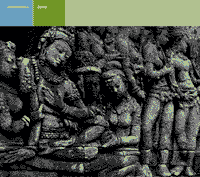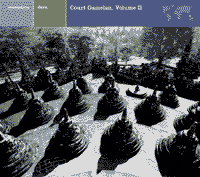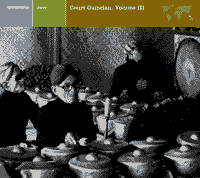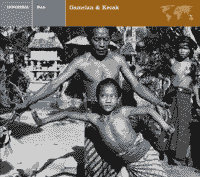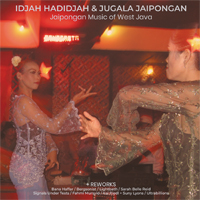
IDJAH HADIDJAH & JUGALA JAIPONGAN
JAIPONG MUSIC OF WEST JAVA (HiveMind HMRLP009)
I don't listen to a lot of Indonesian music but I am not averse to it. I got earworms from a Balinese pop cassette years ago that I played endlessly, and of course got into the Nonesuch/Explorer "Morning of the world" albums recorded by David Lewiston. I also explored the different Degung and Gamelan ensembles and studied gender (hard "g") for a while, but that was before the tsunami of African music hit me. The singing always struck me as oddly atonal and shrill so I did not hold out many expectations for this new release from Hive Mind. But I am glad I listened all the way through because it eventually becomes deconstructed as an exploration of musical forms once the remixers climb aboard. Traditional Jaipongan music developed as a reaction to pop music which was banned by the Indonesian government: sensual dance moves were added from harvesting rituals to spice it up. The basis of this disc is ten tracks recorded in 2007 and uniting Idjah, the most famous singer in the country (who regularly sang with puppet shows), with the gamelan and drums of Bandung's top recording studio musicians. Kai Riedl got hold of the original board tapes so parts could be separated out and gave them to eight of his DJ buds and said go for it. The remixes are quite unearthly and bear little resemblance to the core tapes, to my ears. However they do show that gamelan is still seen as quite exotic, hence the echoes and "spacewashes" from synths. It doesn't really work back-to-back like say Lee Perry versions coming after a Junior Byles song but, jumping about, you might get a sense of continuity, however for me there's not enough remaining of the originals for it to cohere.
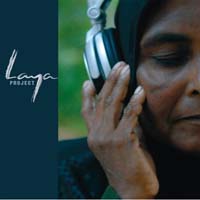
LAYA PROJECT (Earthsync)
Something new and different to tickle you between the ears. This is a project of Earthsync and a response to the tsunami that devastated the coasts of the Indian ocean on Boxing Day 2004. The producers went looking for folk musicians among the survivors. Because the ocean is the unifying factor of cultures as disparate as Myanmar (b.k.a. Burma), the Maldives, Indonesia, India, Sri Lanka and Thailand, there are currents that flow from East Africa and the Middle East and swell around India to Indonesia, unifying the music. The album is very harmonious and consistent, perhaps due also to the production which has added a studio sheen to everything. The in-house contributors are Patrick Sebag who provides keyboard and programming, and Yotam Agam, who engineered, and recorded the Madras Strings at A.R. Rehman's Chennai studios. Paul Jacob adds bass to many tracks. Otherwise each track has different singers and instruments from the beach communities around the Indian Ocean. The first album is great, it opens with a version of "Glorious Sun," (a song that kicks off the second CD) and continues to unfold mysterious and wonderful sounds for an hour. But I am ambivalent about the second disc: if the music is so great it overflows one disc you want to hear more, but sometimes a second disc is just the container of leftover ideas, and I think this project could have been accommodated on a single disc. Disc Two's "Sunset in Akkarai" has spoken comments in English about the music, which are completely unnecessary, and ruin a moody violin solo. The talking continues on the next piece too, "Nium nium" which should have remained instrumental. There is also a DVD, not present in my copy, but it aired on WorldLink TV in June, and will probably return there. The packaging is deluxe, with nice photographs. While the producers stress they are dedicating the project to the survivors of the tsunami there is no mention of them getting the proceeds from sales.
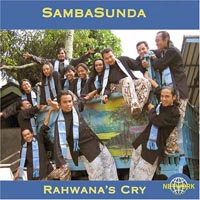
SAMBASUNDA
RAHWANA'S CRY (Network 28.867)
On first listening this is very like the pop music you find blaring all over Bali and Java and can buy in cassettes to remind you of happy trips. The melancholic degung of the Bandung region of Indonesia with its laconic suling (bamboo flute) rising over the metallic shimmer of pongelled gongs is very evocative. It's a bustling gamelan sound with added violin, terompet (a high, piercing oboe in the recorder range), zither and drums, that can transfix you and, if you haven't been there, suggest a rainforest, monkeys, ruined stone gods in the underbrush. SambaSunda has a lot of nuances and this disc will transport you from the tangled thicket to sun drenched beaches, rickshaw-crowded alleys and exotic ritual dances without leaving your armchair. The trancelike quality of Indonesian music recalls ambient insect sounds, wind and rain. These are perfectly transposed to the hammered gongs of the gamelan orchestra. SambaSunda are tight and have superb arrangements so the whole album flows along like a symphony. The only western instrument is the electric bass which grounds the snaking woodwinds, the haunting violin, the plangent kacapi (zither) and other instruments found in Java and Bali. The multitude of instruments do not detract, in fact they give the group a unique style. Founded 10 years ago by Ismet Ruchimat, a teacher at the School of Music, Dance & Dramatic Art in Bandung, the group is interested in assimilating outside influences like samba and reggae into their indigenous styles. They have toured extensively in Malaysia and more recently in Europe in 2003, and released five albums at home. It takes a while to get into this but once you are in, it is a timeless and classic recording.
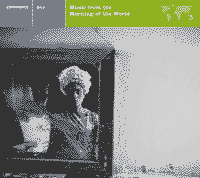 | 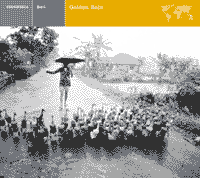 | 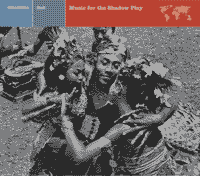
|

| NONESUCH EXPLORER SERIESOne of my first big world music passions was Indonesian gamelan music. My friend Ray Funk, today a great authority on Gospel and Calypso, turned me on to the gamelan records in the Nonesuch Explorer series back in the seventies. These had been recorded by David Lewiston in 1966 and were the first ever "World Music" recordings released in the USA. I became so enamoured of the unearthly sounds on BALI: GOLDEN RAIN and BALI: MUSIC FOR THE SHADOW PLAY that I sought out a teacher and began studying the repertoire for the Balinese shadow play, which is traditionally accompanied by a pair of pentatonic metallophones called gender (with a hard g). Fortunately there has been a strong Indonesian music scene in the San Francisco Bay Area since the days when Lou Harrison taught at Mills College. My teacher was Nick Robinson of Gamelan Sekar Jaya. From Nick, I learned the music in patterns, and the continuo part started to come into my grasp. But a sad thing happened: the knowledge I gained during my years of study with him demystified the music so now when I heard it I didn't see shimmering cascades of fireflies in bamboo groves, I saw the overlapping loops and mentally anatomized the parts. The device was laid bare. I was still amazed at the damping technique (that I could now "see" when I listened) as the heel of the palm brushes against the end of the metal bar to stop the note, but I wanted my wonderment back, and not the technical understanding that reduced the magic to pattern-making in the air. I still love the shadow play repertoire and think of specific pieces as parallel to Tobani's "Hearts & Flowers," Palmgren's "May Night," Engelmann's "Melody of Love," Sinding's "Rustle of Spring," Moszkowski's "Love's Awakening," and other Western hits of the light classical repertoire that accompanied silent movies for thirty years. "Pangkur" from JAVA: THE JASMINE ISLE has all that wonder locked into a magnificent gamelan piece that soars majestically, the stopped notes ringing and disappearing like wisps of smoke and entwining up and down a modal scale as beautiful as Bach or Buxtehude on the pipe organ. It's also wonderful that there are no Western influences on the music, like you find in electrified music from all over the globe. But what of the Explorer series' influence on Western music? I hear Pere Ubu in some of the spacier of the gamelan pieces. For those of an even more adventurous turn, the sung pieces are also quiet eerie. (And it was with adventurous listeners in mind that Tracey Sterne, the guiding genius of Nonesuch, decided to release the entire series of Lewiston's field recordings on the unsuspecting market.) There is the incredibly catchy slow-bluesy "Tonggeret," heard on WEST JAVA: SUNDANESE POPULAR MUSIC. Flute and a jews harp chorus combine magically over hand-drum on "Sekehe Genggong," on BALI, MUSIC FROM THE MORNING OF THE WORLD, one of the most popular recordings in the series, and initially intended as a sampler. Probably the single most famous piece in the series, "Kecak" is a brief excerpt from the Ramayana epic. This so-called "monkey chant" became so popular, Lewiston returned to Bali in 1987 and captured a full performance, heard on KECAK FROM BALI. It inspired numerous Western poets and composers. You can hear where Philip Glass swiped some of his more successful ideas on the simple "Bendrong II" (on JAVA: THE JASMINE ISLE) which takes it down to four hands and four pongels (mallets). What Glass lacks (apart from soul) is the insect chorus heard in the background -- for me a crucial part of the sound. In the days of freeform FM radio, deejays would announce it was time to light up a spliff and put on side two of GOLDEN RAIN, a twenty minute slice of this celebrated chant. For neophytes, some of this music may be hard to take at first. I still can't get into the weird fiddle heard on some of the tracks, and occasionally the operatic works drift into a soporific ponderousness, like "Ketawang Puspawarna" on JAVA COURT GAMELAN VOLUME II. On the other hand, "Gambang" by Gamelan Semar Pegulingan, on GAMELAN OF THE LOVE GOD, is the kind of bustling track I love where the small twined genders rock out over the big bass gongs. (These last two were recorded by Robert E. Brown.) Lewiston continues as a musical tourist and makes an annual trip to Tibet where he asks them to lay off the Hindi film music before he records. But it was certainly a rare moment that he found himself in, catching this pristine ancient sound right before the rest of the world showed up with cassettes of Michael Jackson. Warners were roundly bashed for firing Tracey Sterne and canning the Nonesuch Explorer series as well as their Classical series in 1979. Now they've done the right thing in bringing this music back to the widest audience possible, once again it's poised to inspire another generation of world music explorers. |
